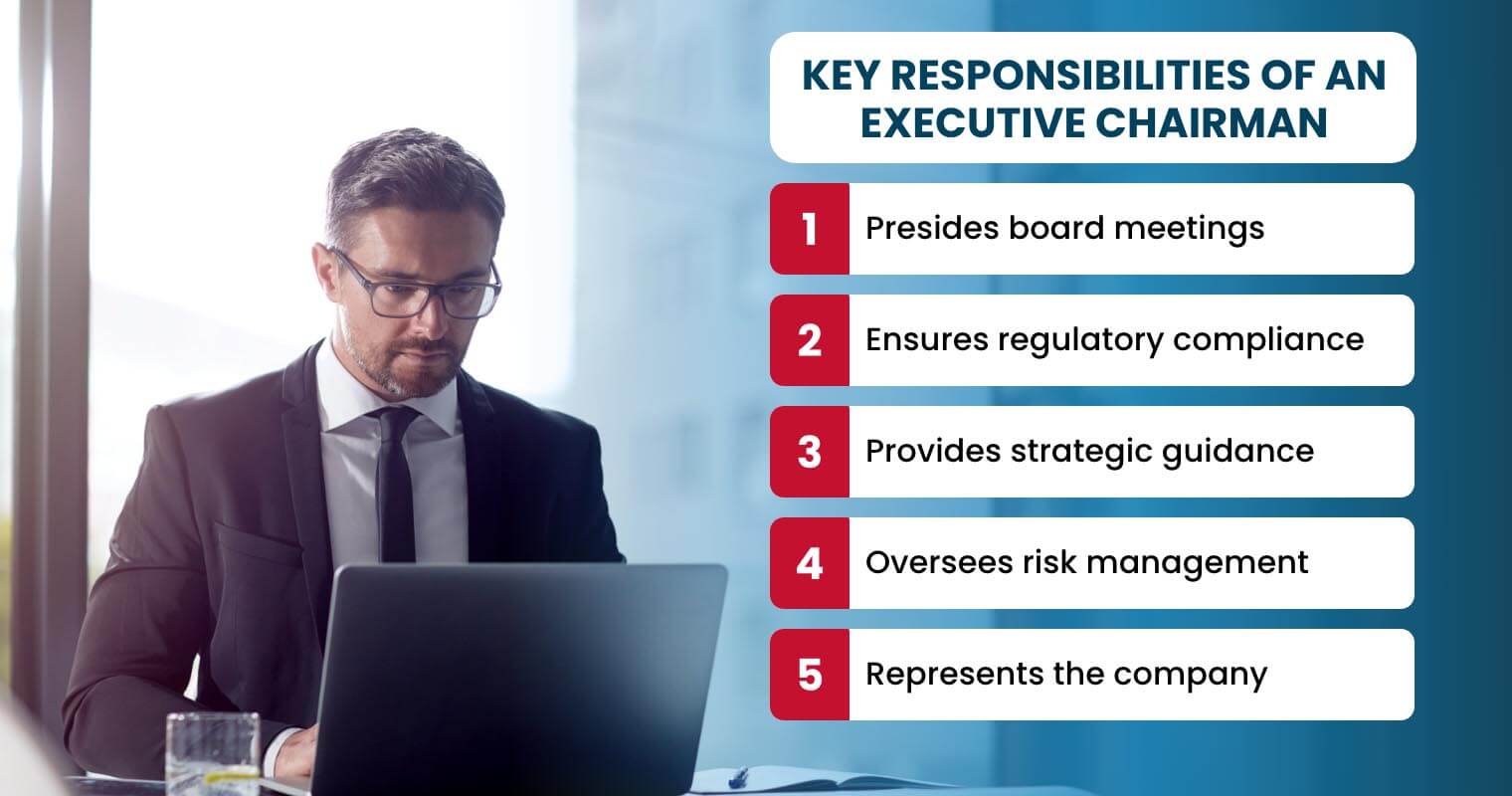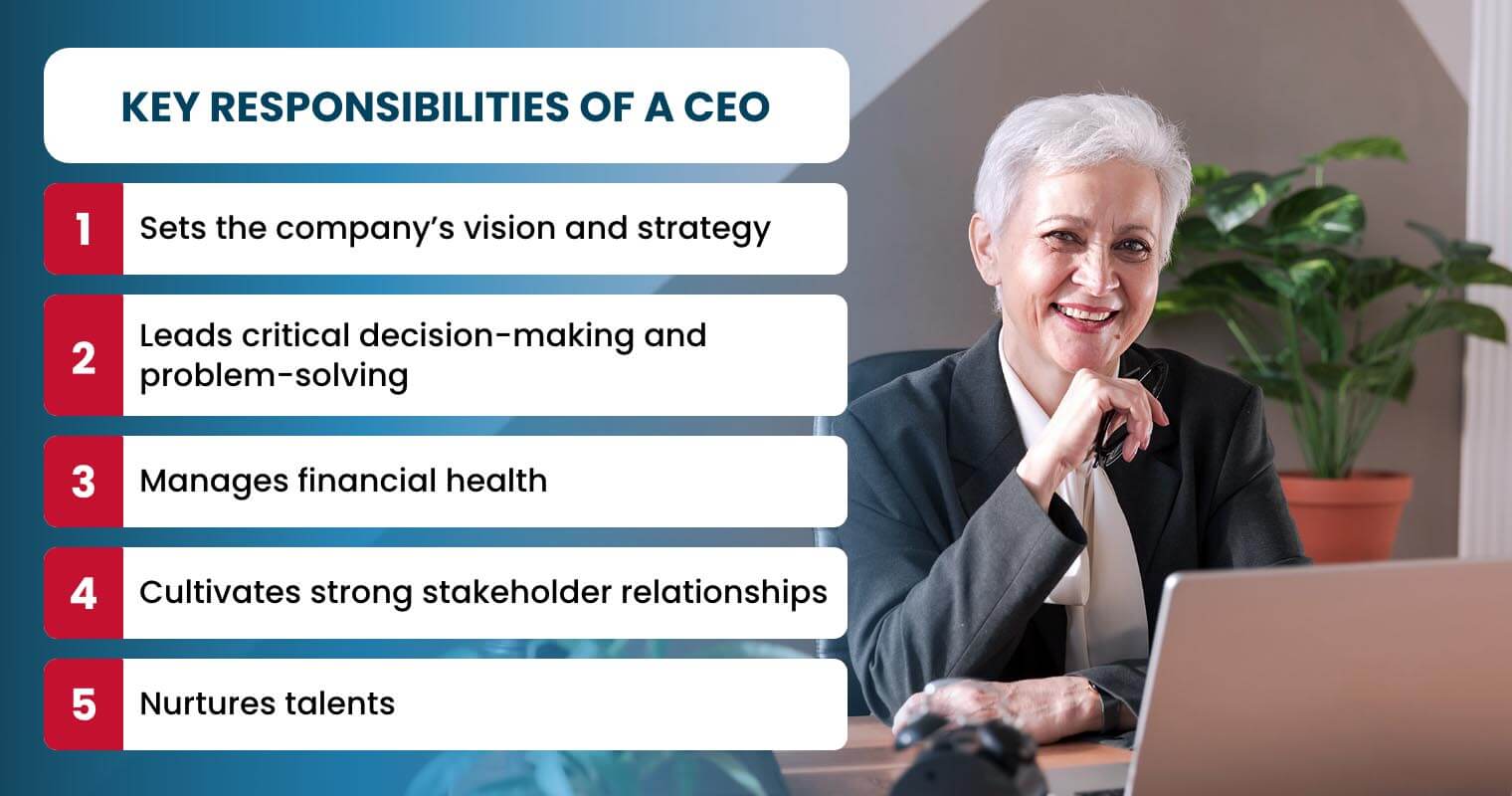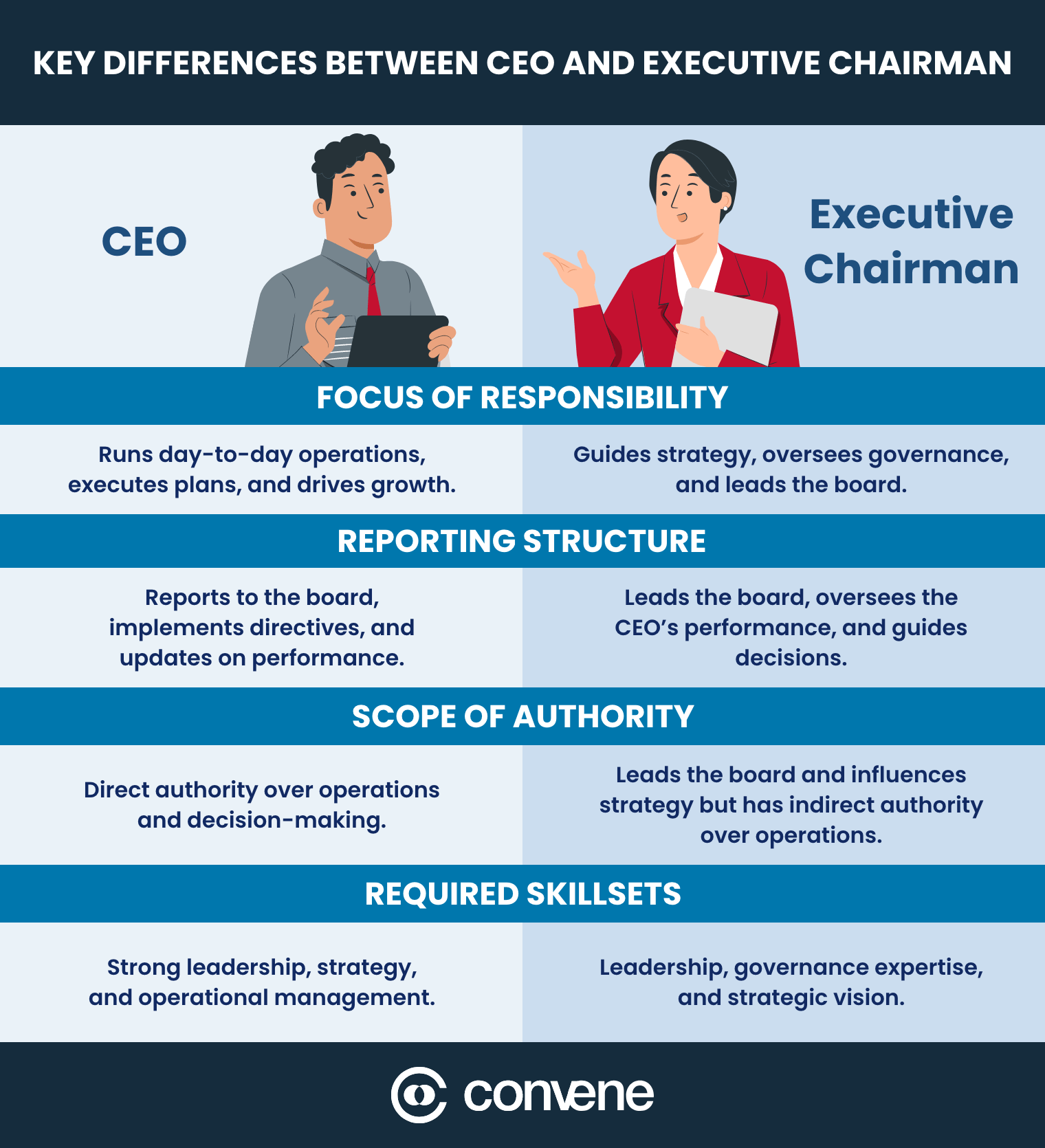Often, people find themselves confused about the roles of an executive chairman and chief executive officer (CEO) within a company. While both roles may seem interchangeable, they serve distinct functions and carry unique responsibilities.
At the core, the difference between executive chairman vs CEO lies in their focus and authority within a company. The CEO primarily oversees day-to-day operations and strategic decisions, while the executive chairman leads the board of directors and guides the CEO.
To help you gain a clearer understanding of the two positions and avoid any misconceptions that may arise, this article will delve deeper into their differences and how one complements the other.
What is an executive chairman?

An executive chairman is a high-ranking executive within a company who typically serves as the head of the board of directors while also holding an executive position. This dual role grants the chair a unique vantage point that enables them to bridge the gap between the boardroom and the executive suite.
Unlike a non-executive chairman, who may not have an operational role, an executive chair is actively involved in the day-to-day management and decision-making of the company. Their level of responsibility can vary based on the company structure, but they typically have a significant role in shaping the organization’s long-term strategy.
What does an executive chairman do?
Since they technically hold two key positions in the company, an executive chairman’s job description entails a spectrum of responsibilities, which include:
1. Presides board meetings
As the head of the board of directors, the executive chairman presides over board meetings, facilitates constructive discussions, and ensures effective governance practices are in place. They must foster open communication and collaboration among board members to effectively address governance issues and drive the company forward.
2. Ensures regulatory compliance
This responsibility involves overseeing the company’s compliance with laws, regulations, and ethical standards. The executive chairman ensures that the company operates with integrity and transparency, upholding the interests of shareholders and other stakeholders while maintaining high standards of corporate behavior.
3. Provides strategic guidance
While the CEO is responsible for day-to-day operations, the executive chair provides insights to the executive team. As they typically have more experience and expertise, executive chairmen act as a sounding board for the CEO; they guide and support the latter in navigating complex challenges and opportunities.
Furthermore, the executive chair collaborates closely with the board of directors, coordinating efforts and making sure they see the plan through to fruition. This role ensures alignment between the company’s initiatives and overarching goals.
4. Oversees risk management
The role of the executive chairman includes assessing and managing risks that may impact the company’s performance or reputation. They work with the board and management to identify potential risks, develop mitigation strategies, and monitor the effectiveness of existing risk management processes to protect the company’s interests.
5. Represents the company
Beyond the confines of the organization, the executive chairman serves as an advocate for the company in public forums, media interviews, and network events. Whether engaging with industry peers, policymakers, or thought leaders, they leverage their influence to advance the company’s agenda and visibility in the marketplace.
Salary
While specific figures fluctuate now and then, as of January 26, 2024, the average salary of an executive chairman in the United States is typically in the range of $316,535 to $539,705. This can vary widely depending on crucial factors such as company size, industry, and experience level.
Qualifications
To qualify as an executive chairman, candidates are preferred to possess an advanced degree such as a Master of Business Administration (MBA) or a related field. However, more importantly, they should demonstrate a track record of success in executive-level positions, ideally as a CEO or in a similar capacity. This proves their capability to lead and guide an organization effectively.
Candidates should also have substantial experience serving on corporate boards, where they can showcase their strategic insight and governance expertise. While not always required, professional accreditations may enhance credibility and validate their commitment to governance best practices.
What is a CEO?

The CEO holds the highest executive position in a company. They make critical corporate decisions, oversee all operations, and strive for the organization’s success. Reporting directly to the board of directors, they are responsible for achieving financial goals, driving innovation, and sustaining the company’s competitive position.
What does a CEO do?
A CEO is responsible for a broad range of duties crucial for a company’s overall success and direction. Some key responsibilities of a CEO include:
1. Sets the company’s vision and strategy
The CEO plays a central role in defining the company’s overarching strategy, which involves analyzing market trends, competitive dynamics, and internal capabilities to identify growth opportunities and develop a roadmap for long-term success.
2. Leads critical decision-making and problem-solving
As the principal executive officer, CEOs make important decisions that impact the company’s future and success. These decisions range from high-stakes choices, such as mergers and acquisitions to operational decisions related to product development, pricing strategies, and resource allocation.
CEOs are expected to be on top of innovation, constantly seeking new ways to drive growth and stay ahead of the competition. This includes embracing technological advancements that can streamline processes, enhance decision-making, and improve communication within the organization. One such advancement is adopting board portals to facilitate better board meetings and document management.
On top of that, they also handle crises and unexpected problems like market downturns, public relations issues, and natural disasters. They work with teams inside and outside the company to tackle issues, lower risks, and safeguard its reputation and interests.
3. Manages financial health
CEOs are in charge of keeping the company financially healthy. They collaborate closely with the CFO and finance team to create budgets, predict financial trends, and plan investments. They also keep an eye on critical financial numbers, handle cash flow, and make choices to guarantee the company stays financially stable and profitable.
4. Cultivates strong stakeholder relationships
Since they usually facilitate and present in annual general meetings, CEOs actively build and maintain relationships with various stakeholders, including investors, customers, partners, suppliers, regulators, and the community. By handling these relationships well, CEOs can garner support for the company’s plans, draw in investments, and improve the company’s reputation.
5. Nurtures talents
CEOs have the vital task of bringing in, keeping, and growing the best talent in their organization–because the work does not stop with recruitment. They hire key leaders, offer leadership growth opportunities, and create a work environment that celebrates diversity, inclusion, and employee involvement.
Salary
In large companies, CEO salaries typically fall between $629,200 and $1,072,700, depending on factors such as industry sector, education, and experience. Smaller companies or startups, on the other hand, may offer lower salaries but potentially higher equity stakes.
Qualifications
While there is no set path to becoming a CEO, individuals often possess a bachelor’s degree in a relevant field such as business, finance, or engineering, with many holding advanced degrees such as an MBA or other professional certifications.
Besides educational qualifications, experience in leadership roles, such as manager or director positions, is highly valued. CEOs typically have a track record of success in their respective industries, demonstrating strategic thinking, decision-making abilities, and effective communication skills.
CEO vs. Executive Chairman: What is the difference?
To make it easier to understand the distinction between the two high-ranking positions, below is a comparison table highlighting the difference between a CEO vs. Executive Chairman:

Frequently Asked Questions About Executive Chairman vs CEO
What is a non-executive chairman?
As the term implies, a non-executive chairman is a member of the board of directors who holds the position of chair but does not have an executive role within the company. Unlike an executive chair, who may have both board leadership and executive responsibilities, a non-executive chair’s role is primarily focused on leading the board, providing independent oversight, and representing the interests of shareholders.
Non-executive chairs are often experienced business leaders or industry experts who bring valuable insights and perspectives to board discussions without involvement in the company’s day-to-day management.
Is the executive chairman higher than the CEO?
The hierarchy between an executive chairman and a CEO can vary depending on the company’s structure. In some cases, the executive chairman may hold a higher position in the organizational hierarchy, especially if they have executive and leadership responsibilities. However, in other organizations, particularly those with a separate CEO and board chair, the CEO may be considered the highest-ranking executive.
Can one person be a CEO and an Executive Chairman at the same time?
Yes, one person can simultaneously hold the CEO and executive chairman roles. This situation is often referred to as a ‘combined CEO and Chairperson’ or ‘dual-hatted’ arrangement. Under these conditions, the individual has ultimate authority and responsibility for both the executive management of the company and the leadership of the board of directors.
While combining these roles can streamline decision-making and promote alignment between management and the board, it can raise concerns about the concentration of power and potential conflicts of interest.
Drive Board Excellence with Convene

Executive Chairmen and CEOs share overarching responsibilities that are distinct yet complimentary. Although their roles may vary in scope, they work in tandem to steer the company toward its goals. This partnership is crucial for enhancing corporate governance and optimizing board performance.
However, ensuring seamless collaboration and communication between the executive chairman, CEO, and the board of directors can be challenging.
That’s where Convene comes in. With its advanced board management features, Convene offers a complete solution to streamline board processes, improve communication, and drive efficiency. From agenda creation and distribution to secure document management and board meeting voting, Convene simplifies every aspect of board governance.
By leveraging Convene’s intuitive platform, everyone in the organization can easily collaborate, access critical information, and make well-informed decisions in real-time.
Unlock your board’s full potential by booking a demo with us today!
Jess is a Content Marketing Writer at Convene who commits herself to creating relevant, easy-to-digest, and SEO-friendly content. Before writing articles on governance and board management, she worked as a creative copywriter for a paint company, where she developed a keen eye for detail and a passion for making complex information accessible and enjoyable for readers. In her free time, she’s absorbed in the most random things. Her recent obsession is watching gardening videos for hours and dreaming of someday having her own kitchen garden.











